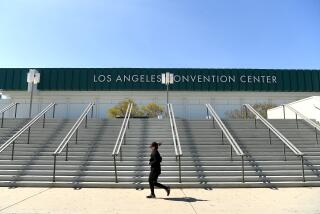Reinforcement of City Hall Is Halted for Cost Study
- Share via
Seismic retrofitting work on Los Angeles City Hall has been stopped indefinitely while a financial analysis is undertaken of soaring cost estimates, the president of the city’s Board of Public Works disclosed Thursday.
J.P. Ellman said that at a meeting of city officials Wednesday, Deputy City Engineer Rodney Haraga made a “ballpark estimate of $238 [million] to $240 million” as the latest probable cost of a project that had been originally estimated at $92.3 million and then early this year had been pegged at $154 million.
But Ellman said no figure is certain, at least until a comprehensive review is undertaken in about two weeks. She said she had actually ordered a halt in work on the next phase of the project a few weeks ago when she got the first inkling of inflated costs.
“Construction work has been stopped on the retrofit,” she said. “Certain design work goes on. But we have decided not to award more contracts. We need a financial analysis. We owe that to everybody in the project.”
All employees working above the fourth floor of the 26-floor City Hall were moved out months ago to allow the retrofitting to proceed. The moving costs were estimated at $22.9 million above and beyond the construction cost.
Ellman said the first phase of work at the top of the building, to stop a crumbling facade, has been completed within the original budget. The next phase was to involve the basement.
Ellman said that some of the estimated new cost increases center on changes demanded in the project by “various government entities” and not necessarily on the seismic reinforcing. Under the three-year plan, City Hall is to be equipped with a system known as “seismic base isolation”--the tallest building in the world to receive such technology.
The term base isolation covers a variety of systems that seek to reduce shaking in a building by installation of shock absorbers in the form of rubber springs, or less commonly, friction sliding bearings at the base of the building. Rubber springs were to be used at City Hall.
Engineers have warned that without a retrofit City Hall would be severely damaged in a new strong quake. But Ellman said Thursday she has been told that, for now, the building is safe for occupancy by municipal officials occupying the lower four floors and the basement.
The retrofitting is only the latest public construction quake repair project to experience sharp rises in cost. Repair of the Los Angeles Memorial Coliseum, for instance, has ended up costing $99.5 million, when it was originally estimated just after the Northridge quake at $35 million.
But at the Coliseum, the federal government has paid close to 90% of the bill. The City Hall retrofitting has so far been paid out of the proceeds of a municipal bond issue, while city officials retain hope of obtaining federal funds from the Federal Emergency Management Agency (FEMA).
Several recent requests for quake repair funds from FEMA by such public entities as Los Angeles County, the Los Angeles Unified School District and UCLA have either been pared drastically by federal authorities or been subject to long delays.
The new cost estimates at City Hall raise questions, if federal money is not obtained, about whether the project can proceed.
But City Council President John Ferraro said Thursday that the city may have little option.
“I’d heard that things were a little bleak a few days ago,” Ferraro said. “Any time you have seismically damaged buildings, you don’t know initially how bad it’s going to be.
“This is an old building, but it’s a building we want to keep,” he said. “We’d have trouble tearing it down. It is a classic historic monument, so important to the city, so we just can’t even think about eliminating our City Hall.”
More to Read
Sign up for Essential California
The most important California stories and recommendations in your inbox every morning.
You may occasionally receive promotional content from the Los Angeles Times.










